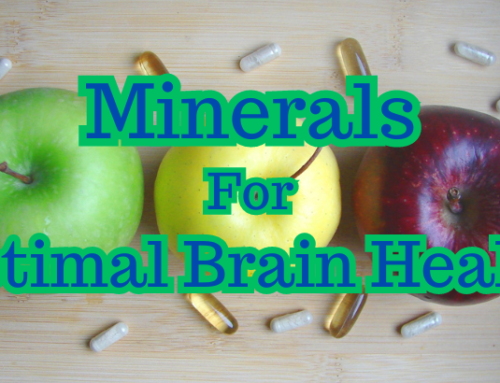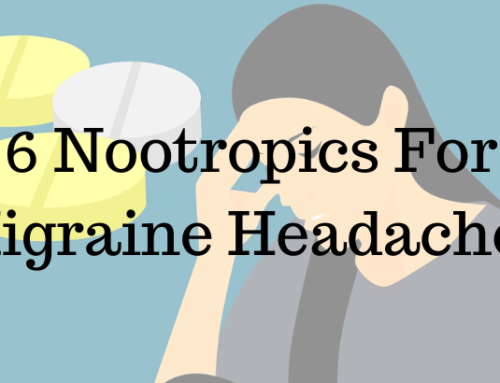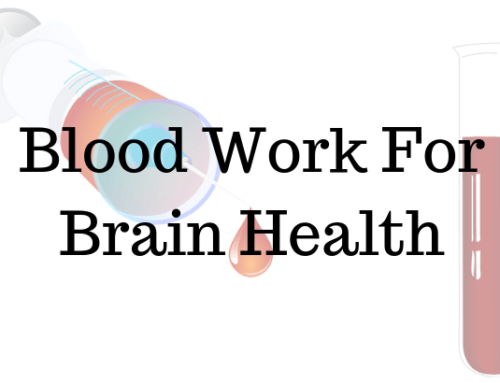It's no secret that proper vitamin and mineral intake is essential for our bodies and brains to function optimally. If we don't get enough, we develop deficiencies. If we get too much, some vitamins and minerals can be harmful when taken in excess.
In another post, we looked at 9 minerals that are needed for optimal brain health. In this post, we're going to look at 13 vitamins our brains need to function optimally. But first, what exactly are vitamins?
What Are Vitamins?
Vitamins are essential nutrients that people need for their bodies – including the brain, of course – to function optimally. Since they are needed in small quantities, vitamins are considered micronutrients. Nutrients we need a lot of like proteins, fats, and carbohydrates are known as macronutrients.
Vitamins have a number of roles in the body. Some are hormones, some are powerful antioxidants, and some assist in cell growth, to name just a few functions. Since our bodies do not produce most vitamins on their own, we must get them from foods and supplements.
Most vitamins can be found in fruits and vegetables. Some vitamins, however, can be found in other foods like meat and eggs. There are 13 essential vitamins that our bodies need. 4 of them are fat soluble and 9 are water soluble.
Water soluble vitamins dissolve in water. These include vitamin C and the B vitamins. When you consume them, your body uses what it needs and your kidneys filter out the rest. Fat soluble vitamins dissolve in fat and are stored, to some extent, in body fat. These include vitamins A, D, E, and K. Now let's take an in-depth look at some specific vitamins.
Vitamins For Optimal Brain Function
Vitamin A

Carrots are a good source of vitamin A.
Vitamin A is a fat-soluble vitamin and a powerful antioxidant. Antioxidants are substances that slow or stop the process of oxidation, which can lead to cellular damage. Vitamin A can be found in a variety of foods including fish, dairy products, and many fruits and vegetables. Some vitamin-A-containing fruits and veggies include carrots, pumpkins, squash, spinach, and other leafy vegetables.
There are a number of bodily processes that vitamin A is involved in.1 One of the most important of these is vision. That's why carrots are considered to be good for your eyes. They contain beta-carotene, which is a provitamin A carotenoid. Provitamins are substances that convert to vitamins in the body.
Vision isn't the only bodily function that vitamin A plays a role in. It's also involved in immune function, gene transcription, cellular health, bone metabolism, embryonic development, and skin health.2 Vitamin A deficiency can lead to night blindness, hyperkeratosis (a skin disorder), and keratomalacia (an eye disorder).3
Vitamin B1 (Thiamine)

Vitamin B1 (also known as thiamine) is a water-soluble vitamin and the first B vitamin to be discovered. It is found in a variety of foods including pork, oatmeal, liver, eggs, brown rice, potatoes, and other vegetables.
Vitamin B1 is involved in several bodily processes including energy production.4 Your body uses vitamin B1 to transform carbohydrates into energy. Carbs provide energy for the body, brain, and the rest of the nervous system. Vitamin B1 also plays a role in the conduction of nerve signals and in muscle contraction.
Deficiency in Vitamin B1 can result in several disorders and, in severe cases, even death. Disorders that can be caused by Vitamin B1 deficiency include beriberi, optic neuropathy, Leigh's Malaise, and Wernicke-Korsakoff Syndrome.5 The popular nootropic sulbutiamine is a synthetic version of Vitamin B1 that has much better bioavailability.
Vitamin B2 (Riboflavin)
 Also known as riboflavin, vitamin B2 is another water-soluble vitamin. It is found in a variety of foods including milk, eggs, cheese, liver, lean meats, leafy vegetables, legumes, mushrooms, and almonds.
Also known as riboflavin, vitamin B2 is another water-soluble vitamin. It is found in a variety of foods including milk, eggs, cheese, liver, lean meats, leafy vegetables, legumes, mushrooms, and almonds.
Vitamin B2 contains two coenzymes, flavin mononucleotide (FMN) and flavin adenine dinucleotide (FAD), that play a role in several important reactions in the body.6 FAD is required for the body to produce another B vitamin – B6. Additionally, FAD is also required to convert vitamin A to retinoic acid and to convert tryptophan to niacin.
Vitamin B2 deficiency can result in a number of disorders including ariboflavinosis, glossitis (inflammation of the tongue), and angular stomatitis (inflammation of the mouth and lips).7 When taken in supplement form, there is some evidence to suggest that vitamin B2 is effective at preventing migraine headaches.8
Vitamin B3 (Niacin)

Vitamin B3 is found in many foods including meats and mushrooms.
This is another water-soluble B vitamin that is also known as niacin or nicotinic acid. Vitamin B3 can be found in a variety of foods including meat, eggs, fish, mushrooms, tree nuts, and several types of vegetables.
Vitamin B3 is involved in a number of bodily functions.9 It plays a role in digestion, skin health, and maintaining the nervous system. Vitamin B3 also plays an important role in converting carbohydrates into energy for the body and brain to use.
Being deficient in vitamin B3 can result in pellagra, which is a disease characterized by six D's: dermatitis, dementia, diarrhea, depression, delirium and, if left untreated, death.10 Sometimes high-dose vitamin B3 is used for it's ability to lower cholesterol levels.11
Vitamin B5 (Pantothenic Acid)

Shiitake mushrooms are high in vitamin B5.
Like the other B vitamins, B5 is water soluble. Also known at pantothenic acid, vitamin B5 can be found in shiitake mushrooms, liver, sunflower seeds, and egg yolks. It's also found in most fortified cereals and infant formulas.
One of the most important roles of Vitamin B5 is that the body uses it to synthesize coenzyme-A (CoA). CoA is needed to produce the neurotransmitters serotonin, dopamine, and acetylcholine. Vitamin B5 also helps our bodies to properly use carbohydrates, proteins, and fats. It helps to convert carbs to energy for our bodies and brain. And Vitamin B5 is known to play a role in skin health.12
Vitamin B5 deficiency is very rare. Since vitamin B5 is used to synthesize coenzyme-A, a deficiency can lead to reduced neurotransmitter levels. This can result in fatigue, apathy, and irritability.13
Vitamin B6 (Pyridoxine)

Tree nuts are high in vitamin B6.
Vitamin B6 is another water-soluble vitamin. Also known as pyridoxine, pyridoxal, or pyridoxamine, it is found in some meats, vegetables, tree nuts, and in bananas.
This B vitamin – like most of the others – plays a number of important roles in the body and brain. Vitamin B6 is used to make antibodies, which the body uses to fight off disease. It's also used to maintain normal nervous system functioning, make hemoglobin, break down proteins, and keep glucose (blood sugar) within normal ranges.14
Vitamin B6 deficiency can cause a variety of symptoms. Some of these include skin problems, glossitis and other types of mouth inflammation, conjunctivitis (eye inflammation), and neurological problems.15
Vitamin B7 (Biotin)

Vitamin B7 deficiency can cause alopecia, aka hair loss.
Another water-soluble vitamin, vitamin B7 is involved in a wide variety of biological processes. Also known as biotin, Vitamin B7 helps the body to turn carbohydrates, fats, and amino acids into energy. This B vitamin can be found in egg yolks, liver, leafy green vegetables, and in peanuts.
Vitamin B7 affects the way the body makes and uses branched-chain amino acids (BCAAs).16 These BCAAs are involved in making tryptophan, serotonin, tyrosine, and phenylalanine. All of these compounds play a crucial role in nervous-system health.
Fortunately, deficiencies of vitamin B7 are rare. In fact, it's so rare that severe vitamin B7 deficiency has never been reported in adults who eat a normal diet.17 Symptoms of vitamin B7 deficiency include alopecia (hair loss), brittle fingernails, conjunctivitis, dermatitis, and neurological problems.18 These include lethargy, depression, and even hallucinations.
Vitamin B9 (Folic Acid)

Green, leafy veggies are high in folate.
Vitamin B9 is yet another water-soluble vitamin. Also known as folate or folic acid, vitamin B9 is involved in a number of biological processes. It's necessary for the production of new cells, for both DNA and RNA synthesis, and for protecting DNA.19 Vitamin B9 is also crucial to brain health.
It's so crucial to brain health that low levels of vitamin B9 has been linked to clinical depression.20 Researchers have been studying the link between low vitamin B9 levels and depression for years. Some people find that taking vitamin B9 reduces or even eliminates the symptoms of their depression.21
Vitamin B9 is found in a variety of foods including pasta, bread, leafy vegetables, liver, and many cereals. Aside from depression, symptoms of vitamin B9 deficiency include weakness, fatigue, irritability, difficulty concentrating, heart palpitations, headache, and shortness of breath.22
Vitamin B12 (Cobalamin)

Vitamin B12 helps to protect neurons (nerve cells).
Here we have yet another water-soluble B vitamin. Also known as cobalamin, vitamin B12 plays a role in the metabolism of every single cell in the human body. It's involved in DNA synthesis and the metabolism of both fatty and amino acids.23
In addition to vitamin B12's role in metabolism and DNA synthesis, it's also indirectly involved in the production of several neurotransmitters including serotonin, dopamine, and norepinephrine.24 And vitamin B12 also helps to preserve myelin. This substance protects and insulates neurons (nerve cells) in the brain and throughout the rest of the nervous system.
Vitamin B12 is found in a variety of foods including meat, chicken, fish, eggs, and milk. Deficiency can cause a number of symptoms, some of which are potentially serious and irreversible. These include fatigue, depression, difficulty walking, lethargy, headaches, breathlessness, pale skin, and memory problems.25
Vitamin C (Ascorbic Acid)
 This is the last water-soluble vitamin on our list of vitamins for optimal brain function. Vitamin C – also known as ascorbic acid – is involved in the production of several neurotransmitters and helps the body to repair certain types of tissue.26 It's also involved in immune function and is a potent antioxidant.
This is the last water-soluble vitamin on our list of vitamins for optimal brain function. Vitamin C – also known as ascorbic acid – is involved in the production of several neurotransmitters and helps the body to repair certain types of tissue.26 It's also involved in immune function and is a potent antioxidant.
Vitamin C is found in a variety of fruits and vegetables including oranges, lemons, plums, papaya, strawberries, and many others. It's also the most widely taken nutritional supplement.27 Many people insist that taking high doses (between 5-50 grams) of vitamin C can reduce the duration of colds. However, there isn't much scientific basis for such claims. Most of the studies that have been done on vitamin C's effect on the common cold have shown that it is not effective.28 Still, there are countless anecdotal reports of people using vitamin C to reduce the severity and duration of colds.
Deficiency in vitamin C results in scurvy, a potentially fatal disease if left untreated. Symptoms of scurvy include soft gums, brown spots on the skin, bleeding from mucous membranes, tooth loss, depression, personality changes, and eventually death.29
Vitamin D

Our bodies use sunlight to make vitamin D.
This is quite possibly the most interesting vitamin on our list. For starters, vitamin D isn't just one thing. It's a group of fat-soluble substances that the body uses for a number of different processes.30 The most important of these substances are cholecalciferol (vitamin D3) and ergocalciferol (vitamin D2).
Another thing that makes vitamin D interesting is the way it's classified. We usually think of it as a vitamin, but it's not a vitamin at all: it's a hormone. Since our bodies are able to naturally make vitamin D from sunlight and because of the way it works in the body, vitamin D is technically a hormone and not a vitamin.31
Though our bodies can make vitamin D from sunlight, we can also get it from several different foods. These include egg yolks, many types of fish, and several different types of mushrooms. Vitamin D helps our bodies to absorb several other vitamins and minerals that are essential for proper brain function including calcium, magnesium, and phosphate.31
Vitamin D deficiency can cause rickets, issues with bone health, skin problems, depression, and a variety of other disorders. On the other end of the spectrum, too much vitamin D can lead to a condition known as Hypervitaminosis D. Symptoms include dehydration, diarrhea, vomiting, irritability, fatigue, constipation, anorexia, and muscle weakness.32
Vitamin E

Vitamin E capsules.
Like vitamin D, vitamin E isn't a single substance – it's a group of eight fat-soluble compounds that include four tocopherols and four tocotrienols. These substances play a vital role in brain function, have antioxidant activity, and help to maintain healthy cells throughout the body.33
Vitamin E plays several roles in the body. It's a potent antioxidant and is involved in gene expression. And vitamin E is known to play a major role in brain health. Studies show that people with the highest levels of vitamin E had the lowest levels of cognitive impairment.34
Vitamin E is present in many different fruits and vegetables, nuts and seeds, and in some oils. Deficiency is rare but can result in neurological problems, hemolytic anemia, eye problems, and immune dysfunction.35
Vitamin K

Like B9, vitamin K is abundant in leafy green veggies.
The last on our list of vitamins for brain health is vitamin K. It is fat soluble and comes in two forms: phytomenadione (K1) and menaquinone (K2). Vitamin K plays a role in protein synthesis, healthy blood cells, and brain cell health.
Vitamin K is needed to make certain lipids that contribute to the formation of myelin.36 If you recall from reading about vitamin B12 above, myelin is a substance that protects cells in the brain and throughout the rest of the nervous system. In addition to helping to form myelin, vitamin K helps nerve cells to communicate with each other.
You can find vitamin K in several foods including leafy green vegetables like spinach and broccoli, egg yolks, and liver. Vitamin K deficiency is rare but can potentially lead to osteoporosis and coronary heart disease.37
Conclusion

One easy way to avoid a vitamin deficiency is to take a multivitamin every day. I've been taking one for years and will continue to do so. Even though my diet is more-or-less balanced and includes plenty of fruits and vegetables, taking a daily multivitamin insures that I maintain healthy vitamin and mineral levels at all times.
There are plenty of multivitamins on the market and many of them are great. Amazon carries a number of trustworthy brands. I personally take this one since it fits my needs perfectly. But if you're female, you might want to check out this one which should suit your needs perfectly.
Do you take a multivitamin daily? Have you noticed any improvements since starting? How about vitamin deficiencies? Have you ever had a deficiency in one-or-more essential vitamins? If so, what did you do to fix it? Please leave your answer in the comments section at the bottom. And if you haven't already, sign up for the Nootropics Zone newsletter below to learn about dozens of brain-boosting supplements.
To learn more about nootropics, sign up for the Nootropics Zone newsletter. You'll get the free gift, The Ultimate Nootropics Quick Reference Guide.
References
1Wolf, G. (2001). The discovery of the visual function of vitamin A. The Journal of Nutrition, 131(6):1647-50.
2Vitamin A. (2019). MedlinePlus, National Library of Medicine, US National Institutes of Health. Retrieved April 19, 2024 from https://medlineplus.gov/ency/article/002400.htm
3Vitamin A: Fact Sheet For Professionals. (2019). National Institute of Health, Office of Dietary Supplements. Retrieved April 19, 2024 from https://ods.od.nih.gov/factsheets/VitaminA-HealthProfessional/
4Thiamine. (2019). MedlinePlus, National Library of Medicine, US National Institutes of Health. Retrieved April 19, 2024 from https://medlineplus.gov/ency/article/002401.htm
5McCandless, D.W. (2010). Thiamine Deficiency and Associate Clinical Disorders. New York, NY: Humana Press. pp. 157-9.
6Riboflavin: Fact Sheet For Health Professionals. (2018). National Institute of Health, Office of Dietary Supplements. Retrieved April 19, 2024 from https://ods.od.nih.gov/factsheets/Riboflavin-HealthProfessional/
7Rutishauser, I., Bates, C., Paul, A., Black, A., Mandal, A., & Patnaikt, B. (1979). Long-term vitamin status and dietary intake of healthy elderly subjects: 1. riboflavin. British Journal of Nutrition, 42(1):33-42.
8Schoenen, J., Jacquy, J., & Lenaerts, M. (1998). Effectiveness of high-dose riboflavin in migraine prophylaxis. A randomized controlled trial. Neurology, 50(2):466-70.
9Niacin. (2017). MedlinePlus, National Library of Medicine, US National Institutes of Health. Retrieved April 19, 2024 from https://medlineplus.gov/ency/article/002409.htm
10Prakash, R., Gandotra, S., Singh, L., Das, B., & Lakra, A. (2008). Rapid resolution of delusional parasitosis in pellagra with niacin augmentation therapy. General Hospital Psychiatry, 30(6):581-584.
11Song, W., & FitzGerald, G. (2013). Niacin, an old drug with a new twist. Journal of Lipid Research, 54(10):2586-94.
12Pantothenic Acid and Biotin. (2023). MedlinePlus, National Library of Medicine, US National Institutes of Health. Retrieved April 19, 2024 from https://medlineplus.gov/ency/article/002410.htm
13Gropper, S., Smith, J., & Groff, J. (2009). Advanced nutrition and human metabolism (5th ed.). Belmont, CA: Wadsworth, Cengage Learning. pp. 338-42.
14Vitamin B6. (2023). MedlinePlus, National Library of Medicine, US National Institutes of Health. Retrieved April 19, 2024 from https://medlineplus.gov/ency/article/002402.htm
15James, W., Elston, D., Treat, J., Rosenbach, M., & Neuhaus, I. (2019). Andrews' Diseases of the Skin (13th ed.). London: Elsevier.
16Hutson, S., Sweatt, A., & LaNoue, K. (2005). Branched-chain amino acid metabolism: Implications for establishing safe intakes. The Journal of Nutrition, 135(6):1557-64.
17Coates, P., Betz, J., Blackman, M., Cragg, G., Levine, M., Moss, J., & White, J. (2015). Encyclopedia of Dietary Supplements (2nd ed.). London:Informa Healthcare. Pp 43-51.
18Biotin: Fact Sheet For Health Professionals. (2022). National Institutes of Health: Office of Dietary Supplements. Retrieved April 19, 2024 from https://ods.od.nih.gov/factsheets/Biotin-HealthProfessional/
19Kamen, B. (1997). Folate and antifolate pharmacology. Seminars In Oncology, 24(5):30-39.
20Gilbody, S., Lightfoot, T., Sheldon, T. (2007). Is low folate a risk factor for depression? A meta-analysis and exploratory of heterogeneity. Journal of Epidemiology & Community Health, 61:631-637.
21Coppen, A., & Bolander-Gouaille. (2005). Treatment of depression: Time to consider folic acid and vitamin B12. Journal of Psychopharmacology, 19(1):59-65.
22Folate: Fact Sheet For Health Professionals. (2022). National Institutes of Health: Office of Dietary Supplements. Retrieved April 19, 2024 from https://ods.od.nih.gov/factsheets/Folate-HealthProfessional/
23Yamada, K. (2013). Cobalt: Its role in health and disease. In: Sigel, A., Sigel, H., & Sigel, R. (eds). Interrelations Between Essential Metal Ions and Human Disease. Metal Ions in Life Sciences, vol 13. Springer, Dordrecht.
24Vitamin B12. (2015). Oregon State University. Linus Pauling Institute: Micronutrient Information Center. Retrieved April 19, 2024 from https://lpi.oregonstate.edu/mic/vitamins/vitamin-B12
25Vitamin B12: Fact Sheet For Health Professionals. (2024). National Institutes of Health: Office of Dietary Supplements. Retrieved April 19, 2024 from https://ods.od.nih.gov/factsheets/vitaminb12-HealthProfessional/
26Vitamin C: Fact Sheet For Health Professionals. (2021). National Institutes of Health: Office of Dietary Supplements. Retrieved April 19, 2024 from https://ods.od.nih.gov/factsheets/VitaminC-HealthProfessional/
27Vitamin C. (2018). Oregon State University. Linus Pauling Institute: Micronutrient Information Center. Retrieved April 19, 2024 from https://lpi.oregonstate.edu/mic/vitamins/vitamin-C
28Hemila, H. (2009). Vitamins and minerals. In: Eccles, R., & Weber, O. (eds). Common Cold. Birkhauser Advances in Infectious Diseases (BAID). Birkhauser Basel.
29Hodges, R., Baker, E., Hood, J., Sauberlich, H., & March, S. (1969). Experimental scurvy in man. The American Journal of Clinical Nutrition, 22(5):535-548.
30Holick, M. (2006). High prevalence of vitamin D inadequacy and implications for health. Mayo Clinic Proceedings, 81(3):353-73.
31Norman, A. (2008). From vitamin D to hormone D: fundamentals of the vitamin D endocrine system essential for good health. American Journal of Clinical Nutrition, 88(2):491S-499S.
31Holick, M. (2004). Sunlight and vitamin D for bone health and prevention of autoimmune diseases, cancers, and cardiovascular disease. American Journal of Clinical Nutrition, 80(6):1678S-1688S.
32Holick, M. (2007). Vitamin D deficiency. New England Journal of Medicine, 357(3):266-281.
33Vitamin E: Fact Sheet For Health Professionals. (2021). National Institutes of Health: Office of Dietary Supplements. Retrieved April 19, 2024 from https://ods.od.nih.gov/factsheets/VitaminE-HealthProfessional/
34Mangialasche, F., Xu, W., Kivipelto, M., Costanzi, E., Ercolani, S., et al. (2012). Tocopherols and tocotrienols plasma levels are associated with cognitive impairment. Neurobiology of Aging, 33(10):2282-2290.
35Brigelius-Flohe, R., & Traber, M. (1999). Vitamin E: function and metabolism. FASEB Journal, 13(10):1145-55.
36Ferland, G. (2012). Vitamin K and the nervous system: an overview of its actions. Advances in Nutrition, 3(2):204-212.
37Geleijnse, J., Vermeer, C., Grobbee, D., Schurgers, L., Knappen, M., et al. (2004). Dietary intake of menaquinone is associated with a reduced risk of coronary heart disease: the Rotterdam Study. The Journal of Nutrition, 134(11):3100-5.
[This article was originally published on July 26, 2019. Updated April 19, 2024.]






Leave a Reply